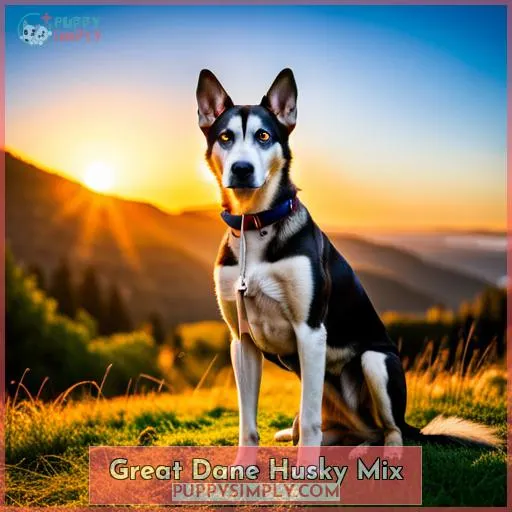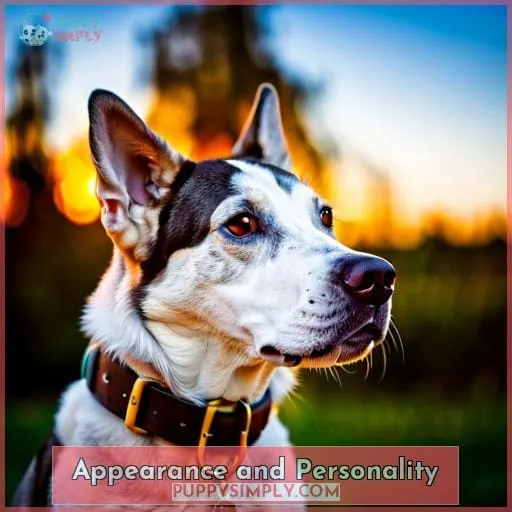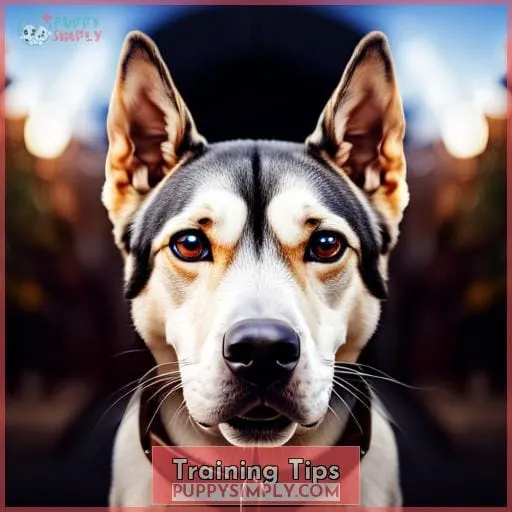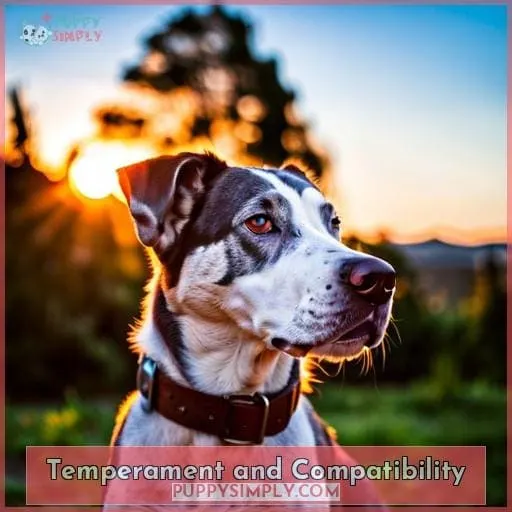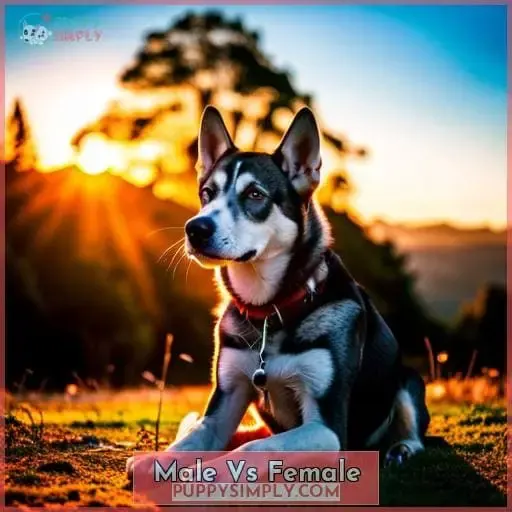This site is supported by our readers. We may earn a commission, at no cost to you, if you purchase through links.

In this article, we will provide all the necessary information to help you decide if a Great Dane Husky mix is right for your home.
Table Of Contents
- Key Takeaways
- Husky Great Dane Mix
- Appearance and Personality
- Health Problems
- Exercise Requirements
- Training Tips
- Grooming Needs
- Food Requirements
- Temperament and Compatibility
- Things to Know Before Owning
- Male Vs Female
- Frequently Asked Questions (FAQs)
- What is the average lifespan of a Great Dane Husky mix?
- How much exercise does a Great Dane Husky mix need daily?
- Is a Great Dane Husky mix suitable for first-time owners?
- Are there any special dietary requirements for a Great Dane Husky mix?
- Are there any common health issues associated with a Great Dane Husky mix?
- Conclusion
Key Takeaways
- The Great Dane Husky Mix is a combination of two different breeds, resulting in a striking appearance with coat colors ranging from white to black.
- They have a friendly nature and make excellent family pets, but socialization from puppyhood is important for getting along with kids and other pets.
- They have moderate exercise needs compared to purebred Huskies, requiring 1-2 hours of exercise daily and ample outdoor space for physical and mental stimulation.
- They are susceptible to various health risks such as hip dysplasia, bloat, osteosarcoma, autoimmune thyroiditis, and eye infections. Proper nutrition and grooming, as well as regular veterinary check-ups, are crucial for their well-being.
Husky Great Dane Mix
You’re considering adding a loyal, energetic, and friendly companion to your family, so the Husky Great Dane Mix could be an ideal choice for you. This hybrid is a striking animal with its white to black coat colors in combinations of fawn, brindle, merle, and harlequin.
It stands between 24-28 inches tall at the shoulder and weighs 60-90 pounds when fully grown.
Exercise needs for this breed are moderate compared to purebred huskies but still require ample outdoor space or activities such as strolling or hiking.
Socialization benefits should also not go unnoticed; early socialization from puppyhood is vital for this mix getting along with kids and other pets later on down the line – consistency here being key!
Health risks include hip dysplasia, which might worsen if food intake isn’t monitored properly – foods high in carbohydrates should therefore be avoided while 20-25% protein must always remain part of their diet plan over regular meals throughout life’s stages (including puppyhood).
Other health concerns include osteosarcoma & GDV (bloat), both requiring immediate medical attention if experienced by your pup ever; additional minor conditions like autoimmune thyroiditis & eye infections may occur occasionally too, though these usually resolve themselves without complication given appropriate diagnosis/treatment plans alongside preventative measures taken beforehand e.
Grooming tips suggest brushing twice weekly minimum & bathing every two months depending upon activity level – stripping fur when necessary helps keep them looking neat.
All things considered, there’s much more than meets the eye regarding owning one o’ these majestic designer dogs, making them highly sought after among active families everywhere today who look forward to enjoying many wonderful adventures together soon thereafter!
Appearance and Personality
A Husky Great Dane mix is a magnificent creature, standing between 24-28 inches and weighing anywhere from 60 to 90 pounds. This hybrid breed has an average lifespan of 7-10 years, making it an ideal companion for active families.
It’s important to note that while the size difference between males and females can be significant—the male may reach up to 28 inches in height whereas the female usually tops out at around 24—both sexes are loyal, outgoing, independent, and playful with people as well as other dogs.
Caring for your pet requires providing proper nutrition by avoiding foods high in carbohydrates while ensuring 20-25% protein remains part of their diet plan throughout all life stages. This helps prevent hip dysplasia or worsening symptoms if they already have it! Grooming also plays a role here; brushing twice weekly minimum & bathing every two months depending on activity level will help keep them looking neat (stripping fur when necessary).
Socialization strategies should include early socialization from puppyhood, which is vital for getting along with kids & other pets later on down the line – consistency here being key! Activity ideas like strolling or hiking require ample outdoor space so boredom doesn’t set in; durable toys such as StarMark Treat Dispensing Chew Ball provide entertainment indoors too.
But don’t forget about mental stimulation either way when planning activities together during playtime sessions regularly.
When it comes time for training tips: starting early focusing on house training + crate training using positive reinforcement instead of punishment techniques goes without saying because these guys are quite independent & stubborn by nature sometimes despite being friendly + playful overall.
To summarize some characteristics benefits owning one o’ these majestic designer dogs bring: 1) Loyalty – They’re naturally affectionate towards you 2) Energy – Siberian Husky brings plenty of energy 3) Patience – Great Dane gene adds patience 4) Playfulness — Both breeds make great companions who love playing games outside plus showing off tricks inside home environments alike!
With strong leadership skills combined alongside consistent training routines multiple times per week conducted at the same time each day dedicated solely devoted toward pup’s development… those familiar traits become even more pronounced over a short period of effort taken on a daily basis.
Both parties involved reap rewards, bringing everyone closer together one paw step further into the lifelong journey that awaits ahead.
Health Problems
It’s important to take proper care of your hybrid pup so they stay healthy, as their genetic makeup can make them more susceptible to certain health issues. These include hip dysplasia, bloat (GDV), osteosarcoma, and progressive retinal atrophy – all of which are hereditary conditions.
To reduce the risk factors for these diseases, it is essential that you provide high-quality food with a 20-25% protein content and limited carbohydrates from simple sources. Moreover, overfeeding should be avoided since this could worsen hip dysplasia symptoms in some cases.
Certain foods such as citrus fruits, raisins, grapes, or chocolate must also be kept out of reach.
Veterinarians recommend supplementing diets with fatty acids like omega 3 & 6, plus antioxidants found in fresh vegetables/fruits – all depending on a pet’s adult size needs too!
Regular physical activities are key for keeping fit and mentally stimulated, but don’t forget about grooming either way when planning routine maintenance sessions. Brushing twice weekly minimum and bathing every two months depending on activity level will help keep them looking neat (stripping fur when necessary).
It’s wise to research some recent studies concerning specific genetic disease problems before buying one of these majestic designer dogs though.
Exercise Requirements
Exercising this hybrid pup regularly is essential to keep them healthy, as they require less activity than their purebred parents. The Great Dane Husky mix may not need the same level of physical exercise as a purebred Siberian Husky, but it should still be given plenty of outdoor activities and mental stimulation in order to stay happy and healthy.
This can include regular strolling sessions, hikes through the neighborhood park or woods, and playing games like fetch with durable toys such as StarMark Treat Dispensing Chew Ball or KONG Extreme Dog Toy for an extra challenge!
Benefits from exercising your puppy include improved muscle tone and joint health, reduced risk of obesity, better digestion due to increased metabolism rate, and enhanced cardiovascular system functioning – all while providing much-needed mental stimulation too!
Additionally:
- Size differences between males and females must be taken into account when planning exercises suited for each individual pet.
- Positive reinforcement, rather than punishment, will yield better long-term results during training sessions that last 10 to 15 minutes at least two times daily (morning and evening preferably).
- Consistency in terms of timing and location is also key since dogs don’t forget quickly, so consistency here matters most indeed!
- Socialization with other animals remains important too, as early exposure helps create trusting relationships over time. All these aspects play an important role in keeping your canine companion fit both physically and mentally, so please do take care accordingly now then alrighty there besties?!
Training Tips
Training your Great Dane Husky mix will require patience, consistency, and positive reinforcement.
- Start early with house training and crate training. This mixed breed is an older breed, so it may take a bit longer to learn the basics of discipline.
- Use positive reinforcement rather than punishment or negative language when teaching commands. Huskies have a strong wanderlust potential that can be easily triggered by aggressiveness in tone or mannerism.
- Socialize young puppies from an early age with other animals as well as people – especially children – to get them used to interacting safely around their environment.
- Establish yourself as the leader of the pack through consistent sessions every day which focus on basic obedience commands such as sit/stay/come etc., plus addressing any misbehaviors quickly yet calmly while also attending closely to meeting each pup’s individual needs (which may include exercise requirements).
As well, don’t forget about one very important factor: grooming! The Siberian Husky part of this hybrid means making sure those thick fur coats stay clean and tangle-free–meaning regular brushing alongside routine bathing throughout its lifetime is essential not only for hygiene but also good health maintenance overall.
In short, consistent routines alongside clear expectations set forth right away leading up into ongoing socialization practices aimed specifically at fostering more respectful behaviors over time combined alongside appropriate grooming measures (as outlined above!) is absolutely key here if you hope to reach success within your pet parenting endeavors.
Grooming Needs
Ensuring your pup’s coat stays clean and tangle-free is essential to good health maintenance, so make sure you provide regular brushing and bathing for your canine companion.
Great Dane Husky mixes are loyal dogs with natural good dispositions that can be a great fit even for small townhouses. They have thicker coats than other breeds, which means shedding levels may vary depending on the individual dog’s genetics.
However, as they shed year-round, it’s important to brush them regularly throughout the season to remove any dead fur or debris from their coats.
Additionally, trimming nails every month should also be part of their grooming routine to help keep those paws healthy! If you want an extra challenge when it comes time for bath day, try introducing hard rubber contraptions like Kong toys into the tub.
This will not only give them something interesting and fun while they bathe but will also help wear down their teeth without having access to chewable items around the house (a common problem among Great Dane Husky mixes).
Finally, don’t forget about ear cleaning too! Dogs often get bacteria buildup within their ears due to moisture retention caused by excessive dirt/debris buildup.
With these tips in mind, plus lots of love and patience, there’s no reason why your furry family member won’t enjoy many happy years full of energy and enthusiasm alongside its human pack members too!
Food Requirements
Feeding your pup the right food is essential for their well-being, so make sure you provide 20-25% protein with limited carbohydrates from simple sources. Great Dane Husky mixes need a balanced diet to ensure they get all the nutrients and energy they need to stay healthy and strong.
A grain-free diet can help reduce allergic reactions in some dogs while still providing enough nutrition for daily activities. Portion sizes should be tailored according to age, activity level, size of parent breeds, and other factors that affect metabolism rate such as stress or illness.
Wet vs dry food is a personal preference, but both types will have similar nutritional benefits if chosen wisely.
In terms of nutrient balance when it comes to this hybrid mix specifically, look out for various antioxidants like vitamin E & C along with fatty acids from fish oil, which are important components of any canine’s dietary plan! Raw feeding may also be considered if done correctly; however, there are risks associated, so use caution when introducing new ingredients into your dog’s meals – speak with a vet first before making drastic changes here!
The breed combination itself tends toward large purebred parents (parentage determines the adult weight), so portion control must remain an absolute priority even though these pooches might seem bottomless pits at times.
Finally, it’s worth noting that keeping up good grooming habits goes hand in hand with proper nutrition – regular brushing helps maintain healthy skin while removing excess fur/debris buildup around the house too! But whatever type of food you choose, just remember: consistency plus quality equals success – not only health-wise but socially as well since socialization requires lots of mental stimulation alongside physical exercise too.
Temperament and Compatibility
When it comes to the Great Dane Husky mix, their temperament and compatibility with other pets and people are as interesting as their unique appearance.
They have an outgoing nature combined with loyalty, playfulness, and patience inherited from both parent breeds: the Great Dane brings its laid-back attitude while the Siberian Husky brings energy that is best channeled through exercise needs.
Leadership skills are important when dealing with these hybrids because they can be independent at times, which may lead to disobedience if not trained properly! Positive reinforcement should be used instead of punishment to encourage good behavior while teaching them basic commands like sit/stay/come.
Socialization is also key since it helps puppies become familiarized early on so they don’t develop any fear or anxiety-related issues later on in life.
In addition, proper physical activity requirements must still be met even though most owners tend towards underestimating how much exercise these mixes actually need – long walks daily plus activities such as strolling or hiking will ensure all-natural breed traits stay intact, including mental stimulation that keeps boredom at bay too!
As far as grooming goes, you won’t need many tools either; regular brushing sessions depending on the dominant coat type should suffice, but always consult professionals first before making drastic changes here! All in all, though, there’s no doubt about it: The Great Dane Husky Mix makes an excellent companion who loves being around humans despite having some independent moments every now and then due to its parent breeds’ strong genetic makeup – just remember consistency is key when training and exercising this pooch regularly, resulting in maximum success overall.
Things to Know Before Owning
Before embarking on this exciting adventure with your adorable pup, make sure you have all the necessary information about their diet and exercise requirements, health concerns, training tips, and more.
Socialization is key for Great Dane Husky mixes. Early introductions to different environments like dog parks will help them become comfortable around people and other dogs.
Feeding sources for this mix include high-protein foods with limited carbohydrates from simple sources such as grains. Overfeeding can exacerbate hip dysplasia, so take care not to exceed recommended amounts.
Health concerns vary depending on the dominant breed, but bloat (GDV) is something owners need to watch out for in particular. If you notice any signs of distress such as abdominal discomfort, it’s a good sign that immediate medical attention may be needed.
Other conditions worth mentioning include autoimmune thyroiditis, heart issues common in purebred Great Danes, and elbow dysplasia, which affects both breeds often occur too.
It’s always best practice consulting veterinary professionals before making drastic changes regarding food intake or physical activity levels! Here are some recommended sites where owners can get further advice: EUKANUBA, ROYAL CANIN, Eagle Pack, Blue Buffalo, Wellness Core, and Dog For Dog.
With proper socialization, leadership training, and plenty of exercise/mental stimulation mixed with consistent feeding habits, owning a Great Dane Husky mix could prove one of life’s great joys filled with lots of fun moments along the way!
Male Vs Female
Comparing males and females of this peculiar hybrid, you’ll find that the size difference between them is quite striking. The Great Dane Husky mix is already known for its large stature, but when it comes to gender, there can be some significant variations in size.
Generally speaking, male Great Danes tend to be larger and heavier than their female counterparts. This means that if you’re considering adding a Great Dane Husky mix to your family as a new pet owner, it’s important to take into account the potential size difference between males and females.
To give you an idea of just how much bigger male Great Dane Husky mixes can get compared to females, let’s take a look at some average measurements:
| Size | Male | Female |
|---|---|---|
| Height | 24-28 inches | 24-27 inches |
| Weight | 60-90 pounds | 45-65 pounds |
As you can see from these numbers alone, male dogs have the potential to grow taller and bulkier than their female counterparts. However, it’s worth noting that each individual dog may vary within these ranges based on factors such as genetics or overall health.
In addition to physical differences in sizing between genders, the behavioral characteristics also differ slightly depending on whether your furry friend is male or female. While both genders share common traits like loyalty, outgoing nature, and playfulness, male Great Dane Huskies are often more independent compared with their female counterparts.
They may exhibit more stubbornness, which could make training somewhat challenging. On the other hand, female Great Dane Huskies tend to be more trainable due to their easier-going nature. Nevertheless, every dog is unique and may not fit these generalizations exactly.
When it comes to exercise requirements, you might expect that males require more activity because of their larger size. However, the truth is that both genders of Great Dane Husky mix require regular exercise to keep them healthy and happy.
It’s important to provide them with ample outdoor space for running and playing, as well as engage in activities such as strolling, hiking, and even mental stimulation through puzzle toys or interactive games.
Lastly, there may be some nutritional differences to consider between male and female Great Dane Husky mixes due to their varying sizes and metabolisms. It’s crucial to ensure that you’re providing a balanced diet with the appropriate amount of protein, carbohydrates, and other essential nutrients for their specific needs.
Consulting with a veterinary professional can help you determine the best dietary plan for your furry companion based on their individual circumstances.
Whether you choose a male or female Great Dane Husky mix, you’ll be adding a striking animal to your family. Each gender has its unique characteristics in terms of size, demeanor, and exercise requirements.
Frequently Asked Questions (FAQs)
What is the average lifespan of a Great Dane Husky mix?
The average lifespan of a Great Dane Husky mix is 7-10 years. While this may seem short, it’s important to note that larger dogs tend to have shorter lifespans compared to smaller breeds.
How much exercise does a Great Dane Husky mix need daily?
A Great Dane Husky mix needs a good amount of exercise daily to stay happy and healthy. Aim for at least 1-2 hours of physical activity, such as walks or playtime, along with mental stimulation through training or puzzle toys.
Is a Great Dane Husky mix suitable for first-time owners?
A Great Dane Husky mix can be suitable for first-time owners who are up for the challenge. With proper training, exercise, and socialization, this striking hybrid can become a loyal and playful companion.
Are there any special dietary requirements for a Great Dane Husky mix?
For a Great Dane Husky mix, it is important to provide a balanced diet with 20-25% protein and limited carbohydrates. Overfeeding can worsen hip dysplasia, so portion control is crucial. Certain foods like citrus fruits and chocolate should be avoided.
Are there any common health issues associated with a Great Dane Husky mix?
Common health issues associated with a Great Dane Husky mix include hip dysplasia, osteosarcoma, bloat (GDV), and progressive retinal atrophy. These conditions can be serious and require proper care to ensure your dog’s well-being.
Conclusion
Owning a Husky-Great Dane mix is a great experience for many. They’re incredibly loyal and outgoing, and make an amazing companion for active families. These unique dogs require plenty of exercise and mental stimulation, but with the right care and training, they can be an absolute joy to have around.
Just be sure to do your research and be aware of their potential health issues and dietary requirements.

